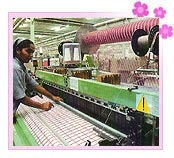 Now if we talk about cotton in the
Indian textile market and in the world trade, then cotton yarn's share from
India is 25%. India is the second largest producer of cotton yarns and
textiles and the third largest producer of cotton. India is also the largest
consumer of cotton in the entire world and second largest in cotton's
production, China being the first. Also the loomage (including handloom) in
textile industry in India is the largest in the world and India contributes
nearly 61% of the total world's loomage.
Now if we talk about cotton in the
Indian textile market and in the world trade, then cotton yarn's share from
India is 25%. India is the second largest producer of cotton yarns and
textiles and the third largest producer of cotton. India is also the largest
consumer of cotton in the entire world and second largest in cotton's
production, China being the first. Also the loomage (including handloom) in
textile industry in India is the largest in the world and India contributes
nearly 61% of the total world's loomage. The ever growing retailing sector and purchasing power of Indian consumer is also markedly affecting the textile industry in India. The lifestyle of middle class consumer is changing dramatically leading to the growth of Indian textile market. In earlier times consumers used to buy bed spreads , bed sheets and other textile furnishing products just during the festive season but now the buying trends are changing. Consumer needs home that is well furnished and depicts the modern decor. The global textile consumption has also increased and each year it is expected to grow by 15%. After China it is the India which is the biggest player of textile industry and global demand for the home textile furnishings has led to the investments in the textile industry in India.
After textile it is the apparel industry that is the second largest industry and retail sector in India. At present the domestic apparel industry is at US$ 2.7 billion and it is expected to grow 5-7 per cent by the end of 2010.
India Textile Industry Facts
- India is the second largest producer of cotton yarn.
- India is the largest in loomage (including handloom) in the world.
- Indian textile market is the second largest employer providing employment to the masses. In textile sector there are about 35 million working people.
- 14% of the industrial production in India is done by the textile industry.
- High exports and foreign revenue comes from the textile industry in India. 38% of the country's total export is coming from textile industry.
- There are around 1200 million medium to large scale textile companies in India
Revival of Khadi: Major Step to Improve Textile Industry in India
Khadi was extensively used in India and considered as the Indian fiber. But with the many other types of clothes and fibers, the Khadi was loosing its importance but now Government is taking steps to revive the Khadi. US$ 150 million offer has been made by the Asian Development Bank (ADB) for the revival of Khadi. Also the Japan Special Fund through ADB will provide US$ 2 million grant to India for the growth of Khadi industry. This will generate employment particularly for women and minorities in rural sector. This is the one step to further boost the Indian textile market at global level.Steps Taken by Government to Boost Textile Industry in India
- Government of India has recently made the scheme regarding Integrated Textile Parks (SITP) under which 40 textile parks will be developed for more investments in textile sector.
- Technology Mission on Cotton (TMC) had been set up by the Government of India in 2000 to further improve the cotton production that in turn will help the Indian textile market to grow. TMC is divided into four mini mission in which Cotton Research & Tech. Generation will be done followed by Transfer of Technology & Development, Development of Market Infrastructure and Modernization/upgradation of G&P factories.
- There will be de-reservation of knitwear, ready made garments and hosiery especially from the small scale sector that will boost the Indian textile market.
- 100 per cent FDI with automatic route.
- Five new schemes for the 11th five-year plans are also coming that will remarkably affect the growth of handloom in India. These schemes are the Integrated Handloom Development scheme, the Marketing and Export Promotion scheme, the Handloom Weavers' Comprehensive Welfare scheme, the Mill Gate Price scheme and the Diversified Handloom Development scheme.
Strength of Textile Industry in India
- Abundant availability of raw material and resources to process them into final product.
- Very knowledgeable and trained manpower to work in Indian textile market.
- Competitive spinning sector
- The most effective retail sector and last but not the least buying tendency of the consumers.
Weakness of Indian Textile Market
- There are many small scale industries in India that are not well integrated with the large companies. This lead to the poor quality of fiber which is not of international standard.
- Labor laws in India are not favorable so India must have a labor reform.
But in spite of these weaknesses and hurdles in textile industries in India it is expected that this sector will touch new heights and continue to grow at the expected speed leading the economic growth and overall development of the nation.



